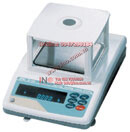The SR844 is the widest bandwidth lock-in amplifier available. It provides uncompromised performance with a frequency range of 25 kHz to 200 MHz and up to 80 dB of drift-free dynamic reserve. The SR844 includes the many features, ease of operation, and programmability that you've come to expect from SRS DSP lock-in amplifiers.
SR844 RF Lock-In Amplifier
- 25 kHz to 200 MHz range
- 80 dB dynamic reserve
- Time constants from 100 µs to 30 ks
(6, 12, 18 or 24 dB/oct rolloff) - "No Time Constant" mode
(10 µs to 20 µs update rate) - Auto-gain, -phase, -reserve & -offset
- Internal or external reference
- Two 16-bit DACs and ADCs
- GPIB and RS-232 interfaces
SR844 RF Lock-In Amplifier
The SR844 is the widest bandwidth lock-in amplifier available. It provides uncompromised performance with a frequency range of 25 kHz to 200 MHz and up to 80 dB of drift-free dynamic reserve. The SR844 includes the many features, ease of operation, and programmability that you've come to expect from SRS DSP lock-in amplifiers.
Digital Technology
The SR844 uses the same advanced DSP technology found in the SR850, SR830 and SR810 lock-in amplifiers. DSP offers many advantages over analog instruments—high dynamic reserve, low zero-drift, accurate RF phase shifts and orthogonality, and digital output filtering.
Signal Input
The SR844 has both 50 Ω and 1 MΩ inputs. The 1 MΩ input is used with high source impedances at low frequencies, or with a standard 10× scope probe. The 50 Ω input provides the best RF signal matching. Full-scale sensitivities range from 1 Vrms (+13 dBm) down to 100 nVrms (-127 dBm). Up to 60 dB of RF attenuation or 20 dB of RF gain can be selected in 20 dB increments. Gain allocation can be optimized to provide up to 80 dB of dynamic reserve.
Reference
The SR844 offers both external and internal reference operation. In both cases, the entire 25 kHz to 200 MHz frequency range is covered without any manual range selection. The external reference input has an auto-threshold feature which locks to sine, square or pulsed signals. The internal reference is digitally synthesized and is adjustable with 3-digit frequency resolution.
Harmonic detection of the 2F component is available for both internal and external reference modes.
A reference output (1.0 Vpp square wave into 50 Ω) which is phase synchronous with the lock-in reference is available in both external and internal mode.
Output Filters
Time constants from 100 µs to 30 ks can be selected with a choice of 6, 12, 18 or 24 dB/oct rolloff. For high-bandwidth, real-time outputs, the filtering can be by-passed entirely. In this "No Filter" mode, the effective time constant is about 30 µs, with the analog outputs updating every 10 to 20 µs.
Ease of Operation
The SR844 is easy to use. All instrument functions are set from the front-panel keypad, and the knob is used to quickly adjust parameters. Up to nine different instrument configurations can be stored in non-volatile memory for fast, reliable instrument setup. Standard RS-232 and GPIB (IEEE-488.2) interfaces provide connections to your data acquisition systems.
Useful Features
Auto-functions allow parameters that are frequently adjusted to be set automatically. Sensitivity, dynamic reserve, phase and offset are each quickly optimized with a simple key stroke.
The offset and expand features are useful for evaluating small fluctuations in your signal. The input is nulled with the auto-offset function, and output expand increases the resolution by up to 100×.
Ratio mode is used to normalize the signal to an externally applied analog voltage. It is useful to eliminate the effect of source intensity fluctuations.
Transfer function measurements can be easily made from the front panel by a programmable scan of up to 11 frequencies. Setups and offsets are recalled at each frequency in the scan.
Analog Inputs and Outputs
The two displays each have a user-defined output for measuring X, Y, R, R(dBm), Θ, and X-noise or Y-noise. Two user-programmable DACs provide -10.5 V to +10.5 V outputs with 1 mV resolution. These outputs may be set from the front panel or via the computer interfaces.
In addition, there are two general purpose analog inputs. These are 16-bit ADCs which can be displayed on the front panel, read over the interface, or used to ratio the input signal.
Internal Memory
The SR844 has two 16,000 point memory buffers for recording the time history of each measurement display at rates up to 512 samples/s. Data may be transferred from the buffers using either interface. A trigger input is also provided to synchronize data recording with external events.






















… [Trackback]
[…] Read More here on that Topic: ino.com.vn/khac-do-luong-kiem-tra/stanford-research-lock-in-amplifier-modelsr844/ […]
… [Trackback]
[…] Info to that Topic: ino.com.vn/khac-do-luong-kiem-tra/stanford-research-lock-in-amplifier-modelsr844/ […]